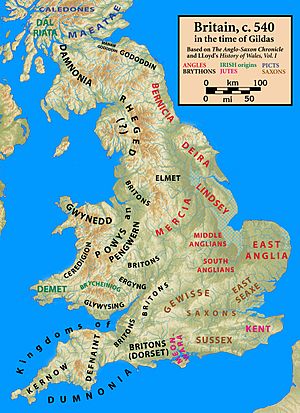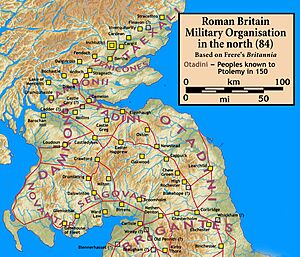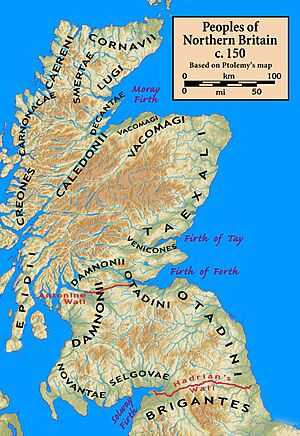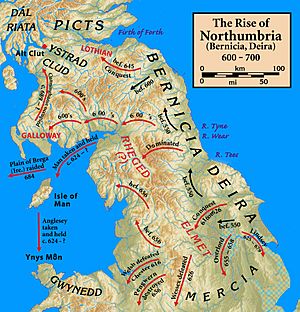Manaw Gododdin facts for kids
Manaw Gododdin was a small coastal area in what is now Scotland. It was located on the south side of the Firth of Forth, a large sea inlet. This region was part of the Kingdom of Gododdin, whose people spoke an old language called Brythonic.
Manaw Gododdin is famous for two main reasons. It was the original home of a leader named Cunedda, who later moved south and conquered North Wales. It was also the home of brave warriors featured in an ancient poem called Y Gododdin.
Sadly, Manaw Gododdin was destroyed in the 600s. It was caught between two expanding groups: the Picts from the north and the Northumbrians from the south. Its land became part of the powerful Kingdom of Northumbria.
The lands both north and south of the Firth of Forth were known as 'Manaw'. But after the Roman era, only the southern part was called Manaw Gododdin. This name showed its connection to the people of Gododdin. Manaw Gododdin was next to – and perhaps even included – Eidyn, the area around modern Edinburgh.
Even though Manaw Gododdin was in modern Scotland, it is also a big part of Welsh history. This is because it was part of Yr Hen Ogledd (which means "The Old North"). The Welsh people and the "Men of the North" (Welsh: Gwŷr y Gogledd) saw themselves as one group, called Cymry. When Cunedda from Manaw Gododdin arrived in Wales around 450 AD, it is often seen as the start of modern Welsh history.
You might see the name written as Manaw Gododdin or Manau Gododdin. In modern Welsh, it is spelled with a 'w'.
Contents
Learning About Manaw Gododdin
It's tricky to find clear information about Manaw Gododdin because it was a long time ago. Historians use old writings and place names to learn about it.
Confusion with the Isle of Man
The Isle of Man is called Ynys Manaw in Welsh. This can make it confusing when old texts just say "Manaw" or "Manau". It's hard to know if they mean Manaw Gododdin or the Isle of Man.
A similar problem happens in Irish. Both the northern Pictish Manaw and the southern Manaw Gododdin were called Manann. The Irish name for the Isle of Man can also be Manann. So, the meaning depends on the rest of the story.
Old Writings and Records
Historians look at several old texts to understand Manaw Gododdin.
Historia Brittonum
The Historia Brittonum is an old history book. In it, a writer named Nennius says that a great king named Mailcun ruled in Gwynedd (part of Wales). Nennius also wrote that Mailcun's ancestor, Cunedda, came from Manaw Gododdin 146 years before Mailcun's rule. Cunedda drove out the Scots (Gaels) from Gwynedd.
The Historia Brittonum also talks about a battle in 655 AD. Oswiu of Northumbria was surrounded at a place called "Iudeu". He offered wealth from "Iudeu" and from "as far as Manaw" to his enemy, Penda of Mercia. Some old copies of this text have slightly different words, which makes it a bit harder to be sure what "Manaw" means here.
Welsh Family Trees
Old Welsh family trees, called genealogies, don't say much directly about Manaw Gododdin. However, they often mention Cunedda. Since he was the ancestor of many Welsh royal families, his connection to Manaw Gododdin is important. All of Cunedda's descendants proudly say they came from Manaw Gododdin.
Annals of Ulster
The Annals of Ulster are old records from Ireland. They mention that Áedán mac Gabráin, a king from Dál Riata, won a "bellum Manonn" (Battle or War at Manonn) in 582 AD.
Scholars disagree if this battle was at Manaw Gododdin or the Isle of Man. Both places are possible, but there isn't enough information to be certain.
Annals of Ulster and Anglo-Saxon Chronicle
The Annals of Ulster also say that in 711 AD, the Northumbrians defeated the Picts at the campus Manann, which means "field of Manaw". The Anglo-Saxon Chronicle, another old record, says this happened in 710 AD. It mentions the battle was "between Haefe and Caere".
People believe "Haefe" and "Caere" refer to the Rivers Avon and Carron in Scotland. This idea was first suggested by William Forbes Skene in 1868. He noted that the Avon River starts near a place still called Slamannan Moor, which means "Moor of Manann". Later historians have agreed with his idea.
Where the Name Still Lives On
The Gaelic form of the name is Manann. We don't know for sure how the names Manaw and Manann are related. In the early Middle Ages, Gaelic replaced Brythonic in the Manaw region. It was common to keep old place names but change how they sounded to fit the new language.
Manaw Gododdin's Legacy
South of the Firth of Forth and River Forth, the name survives in places like Slamannan Moor and the village of Slamannan in Falkirk. These names come from Sliabh Manann, meaning 'Mount Manann'. The name also appears in Dalmeny, near Edinburgh, which was once called Dumanyn, likely from Dun Manann (Fort of Manann).
Pictish Manaw's Legacy
North of the Forth, the name lives on in the town of Clackmannan and its county, Clackmannanshire. This name comes from Clach Manann, meaning 'stone of Manann'. It refers to a special stone monument found there.
Regional History of Manaw Gododdin
The earliest solid information about the Firth of Forth area comes from studying Roman Britain. The homeland of the Votadini people, who later became the Gododdin, did not have many Roman forts. This suggests that the Votadini and the Romans had a friendly agreement, perhaps an alliance. So, these tribes or kingdoms continued to exist during the Roman era. There is no sign that the Romans ever fought against them.
However, the Romans often fought with the people further north, who are now known as the Picts. The Roman military roads, like the northern end of Dere Street, were well-protected. This road went right through Manaw Gododdin.
The first reliable historical mention of the people in Northern Britain comes from a book called Geography by Ptolemy, written around 150 AD. He said that the Otadini (who were the Votadini) lived in this area. Their lands were along the coast of south-eastern Scotland and north-eastern England. This included the lands around the Firth of Forth, both north and south of it.
Ptolemy also said that in 150 AD, the Damnonii and the Otadini owned the land north of the Firth of Forth and south of the Firth of Tay. The Picts kept pushing south. By the early 200s, the Roman Emperor Septimius Severus tried to fight them but didn't succeed. These local Picts, then called the Maeatae, eventually moved south past the Firth of Forth. By the 600s, the Votadini were caught between the Picts and the Anglian people from Bernicia, who were expanding north.
Manaw Gododdin could not survive as a kingdom past the 600s. The Kingdom of Northumbria was becoming very powerful. It would eventually conquer all of Scotland south of the Firths of Clyde and Forth. The most important years were in the mid-600s. In 655 AD, Penda of Mercia led a large group of allies against Bernicia. Penda was defeated and killed at the Battle of Winwaed. This battle ended the alliance and made Bernicia control all of Britain between the English Midlands and the Scottish firths. Bernicia then joined with another kingdom, Deira, to form Northumbria, which became the strongest military power of that time. While Alt Clut (another kingdom) soon became independent again, all other Brythonic kingdoms north of the Solway and Tyne were gone.
|






